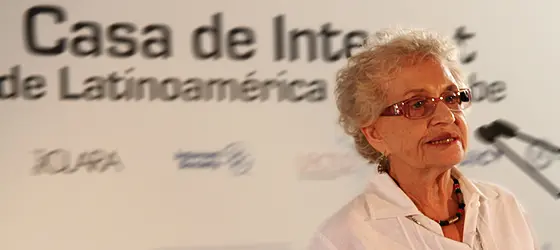Latin American Engineer Inducted to the Internet Hall of Fame
09/07/2013


Ida Holz, a 78-year-old Uruguayan engineer, has joined a small and select group of leaders inducted to the Internet Hall of Fame.
The Internet Hall of Fame is a program established by the Internet Society to publicly recognize Internet pioneers and honor individuals who have made significant contributions to the development and advancement of the global Internet.
Holz is the first Latin American woman to be included on the list of 33 Internet visionaries who are part of the Internet Hall of Fame for their significant contributions to the development and advancement of an open and global Internet.
The Uruguayan scientist had previously received the 2009 Outstanding Achievement Award presented by the Internet Address Registry for Latin America and the Caribbean (LACNIC) for her invaluable contribution to ICTs in our continent.
Characteristically humble, Holz says she does not consider herself to be particularly deserving of this recognition. ”I think they wanted to symbolize in one person their recognition for the tireless work many of us throughout Latin America have carried out aimed at advancing the Internet,” she muses out loud.
Holz was part of the first generation of university graduates trained in Computer Engineering in Uruguay. She was in charge of the Central Computing Service at the University of the Republic in Uruguay for more than 20 years, where she led the creation of the Uruguayan Academic Network and its connection to the Internet back in the early 90s.
During that decade, Holz was part of a group of pioneers whose collaborative efforts led to the development of the first networks, which served as the basis for the Internet in Latin America as we know it today. Holtz recalls those early days: “In 1991, the directors of all Latin American datacenters –or should I say the directors of all Latin American academic networks– were invited to Rio de Janeiro. That meeting –which was huge– was the first meeting I attended. That was also where I saw the Internet for the first time, as obviously Brazil was already connected to the Internet and we were able to do some browsing. There was, at the time, a system with which one could browse the web, but all it had was letters, there were no pictures, no videos, none of the other things we can access today. The meeting was huge (…) There were people from Europe, representatives of European academic networks. There was a Spaniard who was trying to help us Latin Americans organize ourselves, saying that a Latin American academic organization should be created, etc., and that a group of notables, among them himself, Steve Goldstein and I don’t remember who else would try to appoint the persons who were to lead that organization. They talked about this with each delegation, but I told them I did not agree, that we had to do that ourselves. When the proposal was presented, we were told that a person from Uruguay did not agree. I presented the reasons why I did not agree, saying that if we could not govern ourselves and choose our own leaders there was no point in creating anything. I asked them to allow us the next morning so that we, the Latin Americans, could have a meeting by ourselves, with no external interferences. In the end, Latin Americans agreed, and that’s how the Latin America and Caribbean Network Forum was born, an organization that until recently served to bring network representatives together.”
Since 2005, Holtz is a member of the Board of Directors of AGESIC (the Uruguayan Agency for the Information Society), where she has had played a major role in Plan Ceibal, a successful program that provides every child and adolescent who is part of the Uruguayan education system with a personal computer.
(Free access, no subscription required)